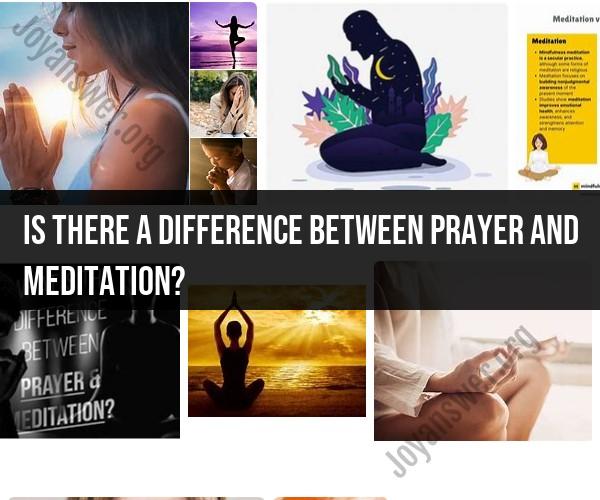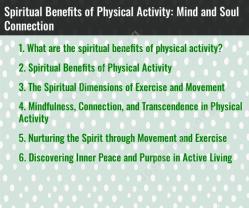Is there a difference between prayer and meditation?
Prayer and meditation are both practices that can help people to connect with their spirituality and inner selves. However, there are some key differences between the two practices.
Prayer is a form of communication with a higher power or being. It can involve talking to God, Allah, Buddha, or another deity. Prayer can also involve asking for guidance, forgiveness, or healing.
Meditation is a practice of focusing the mind on the present moment. It can involve focusing on the breath, a mantra, or a visualization. Meditation can help people to relax, reduce stress, and improve focus.
Here is a table that summarizes the key differences between prayer and meditation:
| Characteristic | Prayer | Meditation |
|---|---|---|
| Purpose | Communicate with a higher power or being | Focus the mind on the present moment |
| Focus | External | Internal |
| Language | Verbal | Non-verbal |
| Structure | May have a set structure or format | Typically unstructured |
| Goals | Gain guidance, forgiveness, healing, etc. | Relax, reduce stress, improve focus, etc. |
It is important to note that these are just general guidelines. There is a great deal of overlap between prayer and meditation, and many people practice both.
For example, some people may pray before meditating to set their intention for the practice. Others may meditate on a prayer or mantra. Ultimately, the best way to decide which practice is right for you is to experiment and see what works best for you.
Prayer vs. Meditation: Distinguishing the Two Practices
Prayer and meditation are both spiritual practices that can be used to connect with a higher power or to achieve inner peace. However, there are some key differences between the two practices.
Prayer is a form of communication with a higher power. It can be done verbally or silently, and it can involve expressing gratitude, asking for help, or simply seeking guidance.
Meditation is a practice of focusing the mind on the present moment. It can be done with or without the use of mantras or other tools.
Here is a table that summarizes the key differences between prayer and meditation:
| Characteristic | Prayer | Meditation |
|---|---|---|
| Purpose | To communicate with a higher power | To focus the mind on the present moment |
| Direction | One-way communication | Non-directive |
| Language | Verbal or silent | Silent |
| Tools | May use mantras or other tools | May use mantras or other tools |
Exploring the Differences Between Prayer and Meditation
One of the key differences between prayer and meditation is the purpose of the practice. Prayer is typically used to communicate with a higher power, while meditation is typically used to focus the mind on the present moment.
Another key difference is the direction of communication. Prayer is typically a one-way communication, with the practitioner addressing the higher power. Meditation, on the other hand, is typically a non-directive practice, with the practitioner focusing on their own inner experience.
Prayer can also be done verbally or silently, while meditation is typically done silently. This is because meditation requires a certain degree of focus and concentration, which can be difficult to maintain if the practitioner is speaking.
Finally, prayer and meditation can both be done with or without the use of tools. However, certain tools, such as mantras or prayer beads, are more commonly associated with prayer.
Prayer and Meditation: Contrasts and Comparisons in Spiritual Disciplines
Prayer and meditation are both important spiritual disciplines in many different religions and spiritual traditions. However, there are some specific ways in which the two practices are contrasted and compared.
For example, in some traditions, prayer is seen as a more active and engaged practice, while meditation is seen as a more passive and receptive practice. In other traditions, prayer is seen as a more personal and intimate practice, while meditation is seen as a more universal and impersonal practice.
Ultimately, the way that prayer and meditation are understood and practiced varies from tradition to tradition. However, both practices can be valuable tools for spiritual growth and development.
Here are some specific examples of how prayer and meditation are contrasted and compared in different spiritual traditions:
- Christianity: In Christianity, prayer is often seen as a conversation with God, while meditation is not typically practiced.
- Buddhism: In Buddhism, both prayer and meditation are important spiritual practices. Prayer is often used to express devotion to the Buddha, while meditation is used to cultivate mindfulness and wisdom.
- Hinduism: In Hinduism, there are many different ways to practice prayer and meditation. Some Hindus may focus on praying to specific deities, while others may focus on meditating on the divine within.
- Islam: In Islam, prayer is one of the five pillars of faith. Muslims pray five times a day facing Mecca. Meditation is not typically practiced in Islam.
Despite these differences, prayer and meditation can both be valuable tools for spiritual growth and development in any tradition.










